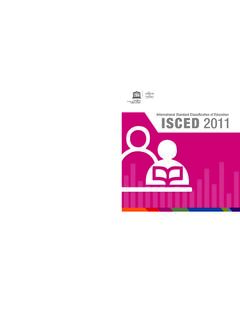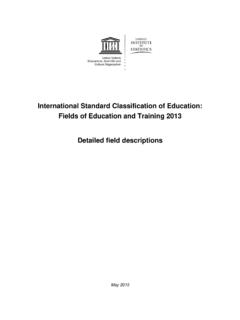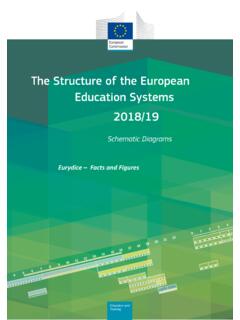Transcription of FINLAND - OECD
1 FINLAND This Data Spotlight note on Early Childhood Education and Care (ECEC) provides a summary of ECEC policy inputs, outputs and outcomes in FINLAND . It uses data available within the OECD Secretariat Education at a Glance, the Programme for International Student Assessment (PISA) and the OECD Family Database to make comparisons between FINLAND s ECEC system and the systems in other OECD countries (see Box 1 for definition and comparability issues). This note complements the 2015 OECD publication, Starting Strong IV: Monitoring Quality in Early Childhood Education and Care. Key characteristics of ECEC in FINLAND : In FINLAND , ECEC caters for children aged 0 to 6 years old; it includes children in pre-primary education.
2 Pre-primary education1 ( isced 02) refers to the year before compulsory school, for children aged 6. Resources that are put in the ECEC system - The share of GDP devoted to ECEC ( isced 0) is higher than the OECD average ( and of GDP respectively) and most spending on ECEC comes from public sources. - Annual expenditure per child in ECEC ( isced 0) is above the OECD average (average (USD 12 092 and USD 8 070 respectively). - The number of children per staff in pre-primary education ( isced 02) is comparatively low: there are about 10 children per teacher in FINLAND , which is 4 children fewer per teacher than the OECD average of 14 children per teacher, excluding the non-teaching staff, such as auxiliary staff. Access and participation - FINLAND provides extensive access to ECEC but participation of 0-2 year-olds in formal care2 (Kindergartens and Family day care in FINLAND ) is lower than the OECD average (28% and 33% respectively).)
3 - Participation of 3-5 year-olds in pre-primary education ( isced 02) is lower than in many OECD countries ( for 3-year-olds rates were 68% in FINLAND compared with 71% across the OECD). - Almost all children aged 6 participate in pre-primary education in FINLAND . Compulsory school starts at age 7. Teacher s academic qualification and working conditions - All teachers of pre-primary education who enter the profession have a Bachelor s degree in FINLAND , as in most other OECD countries. - Salaries of pre-primary ( isced 02) teachers are below the OECD average, in absolute and relative terms. A pre-primary education teacher in FINLAND can expect to earn after 15 years of experience an annual salary of around USD 29 771, this is 10 000 USD less than the average annual salary of their colleagues after 15 years of experience across the OECD (around USD 39 245).
4 Monitoring Quality - Monitoring of ECEC settings is a common, yet local practice in FINLAND . FINLAND is one of few countries where children s views are taken into account when monitoring quality. - While FINLAND implements a wide range of practices to monitor quality in ECEC, several challenges remain. Firstly, there is no shared perspective for quality in ECEC. Setting out clear quality goals in a framework can overcome this. Secondly, FINLAND has no national monitoring system. Standardising certain monitoring tools can create greater coherence in FINLAND s monitoring system. And thirdly, there is limited training on monitoring available which indicates a need for more in-service or on-the-job training (see Monitoring Quality in Early Childhood Education and Care Country Note: FINLAND ).
5 Student performance at age 15 by participation in pre-primary education - The percentage of 15-year-olds in FINLAND who reported not attending pre-primary education in PISA 2012 was considerably low ( compared with across the OECD). Even after accounting for socio-economic background, the relationship between attending pre-primary education and mathematics performance of 15-year-olds is significant and close to the OECD average (34 and 31 score points respectively - equivalent to almost one year of formal schooling). FINLAND 2 OECD 2016 Introduction Participation in ECEC can have a positive effect on children s early learning and development, as well as on subsequent outcomes, such as academic success, labour market performance and socio-economic mobility.
6 The benefits of ECEC on child outcomes, however, depend on the quality of the provision. Settings and programmes that have a high level of quality are positively associated with children s cognitive, social and behavioural development, with disadvantaged children benefitting significantly from high-quality settings (OECD, 2011; Gambaro et al., 2014). Policy outcomes are associated with both policy inputs and policy outputs. For simplicity purposes, this note uses the term early childhood education and care (ECEC) to refer to arrangements providing care and education for children under compulsory school age. This term differs from those used by other sources in this note, including the isced 2011 classification (see Box 1 for the isced 2011 methodological distinction between childcare and pre-primary education).
7 Because of these differences in definitions, caution is needed when comparing data presented here. The note is structured in three sections: Policy inputs: This section presents indicators of the resources that are put into a system, such as the level and type of sources that finance ECEC, and the regulations of staff-child ratios to achieve outputs or a result. Policy outputs: This section covers indicators that are the result of policy inputs put in place, such as enrolment rates by age. Trend data is presented to examine the changes in early childhood education in recent years. Policy outcomes: This section covers indicators on the outcomes of children that are associated with both policy inputs and policy outputs.
8 For example, indicators on student performance at age 15 by participation in pre-primary education (drawn from PISA 2012). Section 1. Policy inputs Extensive access to ECEC services The organisation of ECEC services varies greatly from country to country in terms of structure, but also regarding the age of children attending different types of settings or the intensity of child participation in different settings (see Box 1). In FINLAND , all services for 0-6 year-olds are called early childhood education and care. Integrated programmes are offered, which include education and childcare services. Children below the age of 3 are entitled to early childhood educational development programmes ( isced 01), which include kindergartens and family day care.
9 Children aged 3-6 are entitled to pre-primary education programmes ( isced 02) provided in kindergartens, pre-primary schools or family day care (OECD, 2016a, Tables and ). Participation in ECEC services may be supported by subsidised places for all children, or for certain age groups and/or target-group children, such as those from disadvantaged backgrounds. FINLAND is among the few OECD countries (alongside Germany, Norway and Sweden) where there is a legal entitlement3 to an ECEC place for all children aged 0-6 (starting age of compulsory school is 7 in FINLAND ). The maximum hours that 0-6 year-olds can have access to is approximately 10 hours a day. In FINLAND , it is possible to attend ECEC services in the evening, on the weekend and during holidays when parents are working.
10 ECEC services are free for low-income families in FINLAND (OECD, 2015a, Table ). FINLAND OECD 2016 3 Box 1. Distinction between early childhood educational development and pre-primary education: The revised isced 2011 classification There are many different ECEC systems and structures within OECD countries. Consequently, there is also a range of different approaches to identifying the boundary between early childhood education and childcare. The International Standard Classification of Education ( isced ) defines internationally comparable levels of education. In isced 2011, level 0 covers early childhood education for all ages, including very young children. As the educational properties of isced 0 programmes can be difficult to assess directly, several criteria are used to come up with a technical definition.

















